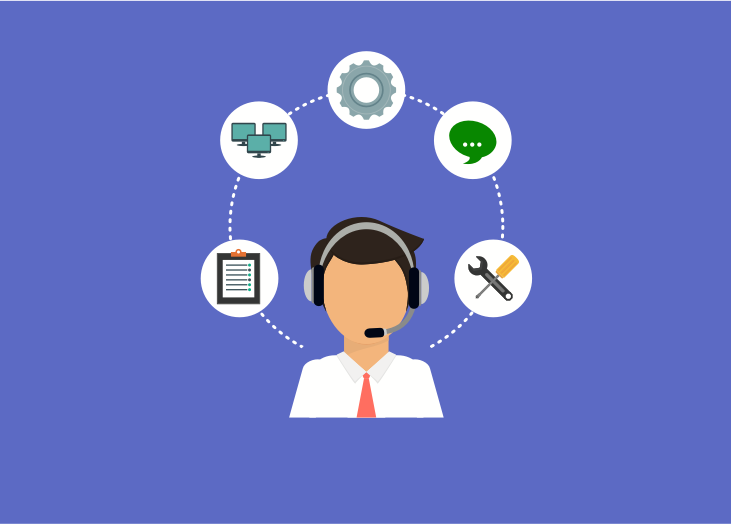What Are the Best Measurable KPIs for Customer Service?

For many businesses, great customer service is the key to future success and customer retention. Being able to effectively manage customers and resolve issues helps to improve customer satisfaction (CSAT) so they’re more likely to return for repeat business or be receptive to upsell opportunities. But, how can you measure the quality and effectiveness of customer service in your company?
Key performance indicators (KPIs) are the most common tool for measuring employee performance. However, to get the most out of tracking customer service metrics, it’s important to use the right KPIs—ones that are measurable and specific.
It should be noted that some businesses may track different customer service metrics than others or apply different terms for specific KPIs. For example, a customer support call center may track “tickets” while a high-end services provider might refer to them as “cases.” Both of these customer service metrics involve unique interactions with customers, but have tweaked names to match a specific industry.
To help you track your company’s own efforts, here’s a list of some of the best measurable KPIs for customer service that you should monitor:
Measurable KPIs for customer service.
- Tickets Opened Each Day. How many tickets/cases/customer interactions does an employee, team, or the company as a whole process each day? This is an important customer service metric to track for monitoring the workloads being handled. Individual-level “Tickets Opened” metrics allow for comparisons of productivity, while team or business-level tracking helps establish overall workload.
- Tickets Closed Each Day. Simply opening a ticket doesn’t mean that the issues behind it are going to be resolved. Until a ticket closes, that customer/client is left waiting. If the number of closed tickets is far below the number opened, it can be indicative of a problem (such as insufficient labor to keep up with workloads, or employees not having the right tools and training to close tickets properly).
- Time to Resolution. On average, how long does it take for a ticket to close? Time to resolution is an important KPI for measuring employee performance. If one employee’s time to resolution is particularly long compared to others working on similar issues, it may indicate an opportunity for improvement.
- First Contact Resolution Rate. What percentage of ticket resolutions occur during the first contact with the customer/client? While it may not be possible to resolve every issue in a single interaction, tracking first contact resolution rate helps highlight the overall complexity of issues faced by the customer service team. This makes it a useful measurable KPI for customer service to track.
- Handle Time. How much time does an employee spend on each ticket? Note that this customer service metric, while closely related to resolution time, is distinct because it is a measure of actual time spent working on the ticket—which may not be the time the customer spends waiting for a resolution.
- Time to Response. Once a customer opens a ticket or dials the support number, how long do they have to wait for a response? Time to response is a critical customer support metric that has a direct impact on CSAT and retention. It may also be a factor in satisfying service level agreements (SLAs) for some companies.
- Service Activity Metrics. Companies can track individual activities made by employees (such as number of phone calls made, emails written, etc.) in the course of responding to and handling tickets. These metrics should be filtered by specific activity type to help correlate specific activities with service ticket outcomes. For example, do employees who make more calls have a higher or lower CSAT score than others? This can be useful when planning new hire employee training so it focuses on those activities that generate the best ROI.
- Churn Rate. One of the most important measurable KPIs for customer service is the company’s overall churn rate—or the number of customers that stop doing business with the company over a given period of time. High churn rates not only indicate a problem with the quality of customer service provided, but it can eventually cause a business to fail if too many customers leave before they can be replaced with new ones. A success team can help with keeping this KPI on track.
- CSAT Scores. Customer satisfaction is one of the most obvious KPIs for customer service that a business should track—but one where it is often hard to collect reliable data. Surveys are a common method of getting this data, but the results often skew overly positive or negative because only those customers who had a particularly impactful experience (one way or the other) have a strong motivation to fill out a satisfaction survey. However, even with this issue, CSAT is an important customer service metric to track.
- Customer Complaint Rates. How many customers reach out to complain about the service they’ve received? This is a measurable KPI for customer service that helps to highlight issues in the service team. If there are a high number of customer complaints during a specific period, it can help to review any changes made during that time frame to isolate a cause. It can also help to review specific complaints to see what they’re about.
Things to keep in mind when tracking KPIs for customer service
Many of the customer service metrics listed above can be measured at different levels. For example, you could track time to resolution on an individual level, a team level, or a company-wide level. Tracking KPIs for customer service at all levels can provide value in various ways.
Tracking time to resolution on a team or company level provides an average to compare individual performance against. This, in turn, makes it easier to identify when someone could improve their performance or is being especially efficient. In the former case, the employee could be put through some additional training to help them. In the latter case, you could study what that employee does differently and apply that to the rest of your processes.
Another thing to keep in mind is that none of these KPIs for customer service should be considered by themselves. They need to be considered as small puzzle pieces that form a bigger picture. For example, say one employee has an especially fast time to resolution. That sounds good, right? However, what are the churn rate and customer complaint rate for the employee’s clients? How often do those customers come back with another ticket to fix right after?
Getting the job done fast is not necessarily synonymous with getting the job done right.
On the other hand, say an employee has a relatively long time to resolution and handle time—something around 25% longer than others handling similar tickets. Based on these customer service metrics alone, it would be easy to assume the employee’s performance is subpar. However, what if the other measurable KPIs for customer service provided by this employee are all extremely positive compared to the average for the business—such as having 50% less churn among clients they handle or having 50% higher CSAT scores?
In this case, it might demonstrate that other customer service team members might need to start spending more time on each ticket to provide superior service. Additionally, if they have more service activities logged to correlate to the longer time to resolution, it can help to demonstrate how much more that employee is doing to provide top-notch customer service.
These are just a few of the best measurable KPIs for customer service that businesses can track. Do you need help creating a simple and effective dashboard for measuring key performance indicators amongst your team? Reach out to BrightGauge today for assistance!
*This post was originally published in May 2019
Free MSA Template
Whether you’re planning your first managed services agreement, or you’re ready to overhaul your existing version, we've got you covered!



